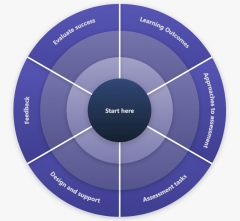After widespread consultations across faculty teaching and teaching support staff, particularly with the Education Focussed community, we identified the need to promote and scaffold assessment resources developed at UNSW providing perspectives on good assessment practice. As a result, the Assessment Framework was developed by Professor Bob Fox, with Educational Developers, Dr Ben Phipps and Clem Wong. The Assessment Framework identifies 6 easy-to-understand dimensions about assessment, helping staff to better understand and put into practice effective assessment strategies that improve the student learning experience. The Assessment Framework leverages new and existing resources to help the UNSW teaching community achieve the Educational Excellence goals of the Strategy Update 2025.
The Teaching Gateway has many excellent resources, and the Assessment Framework provides the nexus - curating resources by the dimensions of assessment design and practice in higher education. The interactive web tool promotes a broad view of effective assessment practices while encouraging the development of new strategies for assessing higher order thinking. Teaching staff are prompted to think about how to effectively address the needs of students in productive ways, assess inclusively, utilise students' abilities to support each other and align assessment tasks to learning outcomes. In particular, it encourages a view of assessment that is integrated into the learning process, to build student graduate capabilities using authentic assessments designed around real-world problems and scenarios. All approaches to assessment - from building foundational skills and knowledge, collaborative work environments and guiding inquiry-based learning - are given a place within the design of courses and programs.
The framework incorporates:
- An evidenced way to identify priorities in assessment design to facilitate enhancement and improve student learning experiences, supported by assessment literature
- Resources that support staff to evaluate the effectiveness of their assessments and measure whether their assessments adequately enable students to demonstrate that they have successfully achieved the program/course learning outcomes
- Additional resources on improving both staff and student (digital) assessment literacies
- A common understanding of different approaches to assessment; its context and purpose
- Targeted case studies that feature good practice in assessment design and delivery
| Dimension | Purpose of dimensions and identified needs of assessment practice at UNSW |
| Learning outcomes | Students have stated that they feel learning outcomes could be more accurately reflected in assessment tasks and teacher expectations. This dimension introduces resources that promote the use of learning outcomes to create effective assessments that enable students to demonstrate that they have successfully addressed the course/program learning outcomes. |
| Approach to assessment | Based on student feedback across the tertiary sector, when the purpose and context of an assessment are clearly identified, students are more likely to be engaged and achieve their potential. This dimension aims to help teachers better identify the goals of their assessment and the student learning they need to make visible. It focusses on more student-centred learning design. |
| Assessment task | This section explores a range of assessment tasks that may be suited to a particular approach to assessment. It provides resources on different assessment types, including traditional types of assessment as well as alternate types such as studio-based tasks. |
| Design and support | Designing assessment that includes structures and support that enable equitable access and student learning is essential. This dimension engages teachers with resources about assessing inclusively, considering cultural sensitivities, and strategies to enhance student support before, during and after assessment according to varied student needs. |
| Feedback | Feedback is identified as a key driver of student learning. Indeed, UNSW data indicates that students' value timely and quality feedback. This section identifies resources and links to resources on providing and receiving feedback. It also helps staff identify levels and types of feedback for different contexts, shows them how to leverage feedback from students and external sources, and provides examples of feedback. |
| Evaluation of success | UNSW staff have identified evaluating the success of their own assessments as a significant area in which they need more support. Looking forward, teachers would appreciate more information to determine the success of their assessment and make improvements. This section identifies resources and peer collaboration between teachers as key drivers in determining assessment success. Criteria for conducting self-assessment of assessment design and feedback processes is also provided. |
Authors: Dr Ben Phipps, Clem Wong & Dr Amanda Yeung
